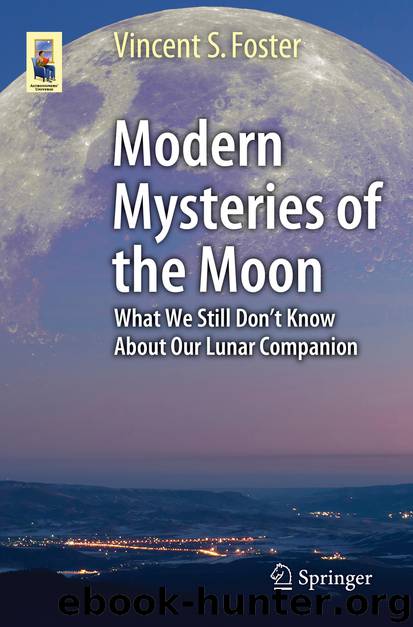Modern Mysteries of the Moon by Vincent S. Foster

Author:Vincent S. Foster
Language: eng
Format: epub
Publisher: Springer International Publishing, Cham
New Computers Uncover Old Moonquakes
In the category of “good research takes time,” scientists have just discovered more than 100 quakes that occurred on the Moon three decades ago.
Seemingly combining archaeology and modern computer science, several groups of researchers have exhumed data from the Apollo landings and taken a closer look at them to improve their understanding of what the Moon is made of and why its inside trembles.
“It’s a very exciting dataset,” said Dr. Yosio Nakamura , a geophysicist at the University of Texas, who was among the scientists who analyzed the seismographs in the 1970s and continues to work on them today.
The lunar landers for Apollo 11 –16 carried seismometers, the same type of instruments that measure earthquakes on Earth, designed to be left behind and to continue to radio back data after the astronauts left. Apollo 11 left a prototype that failed after a month, and Apollo 13, which was almost lost when its oxygen tank exploded, never made it to the lunar surface. But the four other seismometers, from Apollo 12 , 14, 15, and 16, recorded some 12,500 seismic events through 1977, when NASA turned the network off.
As expected, the Moon shuddered when hit by small meteors. There were a handful of deliberate tremors when discarded parts of the Apollo spacecraft were sent crashing onto the lunar surface.
The seismometers also recorded 28 shallow “moonquakes” over 8 years, the largest about magnitude 5.0. But more unexpected and still not well understood were numerous tiny moonquakes, several a day on average, that occurred far below, 500–750 miles down, about halfway to the Moon’s center.
“That’s deeper than any earthquake we see on the Earth,” said Dr. Catherine L. Johnson , a geophysicist at the Scripps Institution of Oceanography in San Diego. “It tells you something about the ability of the middle of the Moon to fracture.”
Nearly identical squiggles emerged from the Moon seismographs over and over, indicating that certain parts of the Moon’s interior broke repeatedly in the same way, almost like someone cracking his knuckles. Dr. Nakamura and other scientists counted 108 of these regions, which they called nests. The rate of moonquakes seemed to ebb and flow over every 27 days, the time it takes the Moon to circle Earth, suggesting that they were caused by the pull of tidal forces.
Almost all of the deep moonquakes originated on the near side of the Moon, the side that always faces Earth. This meant that either the structure of the far side is different and does not experience moonquakes or moonquakes do occur, but the waves dissipate when they hit a still molten core.
That was the unsatisfying, unresolved conclusion to Dr. Nakamura ’s initial studies 20 years ago. He also could not figure out the sources for more than 9000 of 12,500 events in the seismographs at that time.
The difficulty then lay in the limits of early computers. The four seismometers on the Moon were advanced for their era, recording the data digitally and radioing the information to Earth in real time.
Download
This site does not store any files on its server. We only index and link to content provided by other sites. Please contact the content providers to delete copyright contents if any and email us, we'll remove relevant links or contents immediately.
Tools of Titans by Timothy Ferriss(7816)
Turbulence by E. J. Noyes(7702)
Astrophysics for People in a Hurry by Neil DeGrasse Tyson(5002)
Secrets of Antigravity Propulsion: Tesla, UFOs, and Classified Aerospace Technology by Ph.D. Paul A. Laviolette(4996)
Design of Trajectory Optimization Approach for Space Maneuver Vehicle Skip Entry Problems by Runqi Chai & Al Savvaris & Antonios Tsourdos & Senchun Chai(4843)
Room 212 by Kate Stewart(4739)
Pale Blue Dot by Carl Sagan(4619)
The David Icke Guide to the Global Conspiracy (and how to end it) by David Icke(4382)
A Journey Through Divination and Astronomy by Publishing Pottermore(4250)
Apollo 8 by Jeffrey Kluger(3513)
Goodbye Paradise(3446)
Losing the Nobel Prize by Brian Keating(3425)
COSMOS by Carl Sagan(3350)
The Five People You Meet in Heaven by Mitch Albom(3335)
How to Read Water: Clues and Patterns from Puddles to the Sea (Natural Navigation) by Tristan Gooley(3240)
Brief Answers to the Big Questions by Stephen Hawking(3239)
How to Read Nature by Tristan Gooley(3080)
The Order of Time by Carlo Rovelli(3073)
A Brief History of Time by Stephen Hawking(2819)
